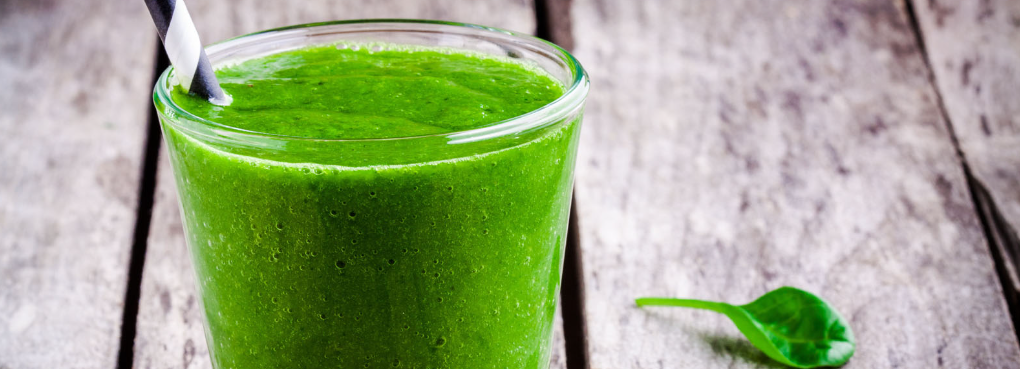I blame Jamba Juice. And any other fast-food chain restaurant that offers sweet smoothies touting them as a healthy alternative to coffee and sodas. Most of the time, there’s no real food in these smoothies. In the best case, a banana and a splash of orange juice are the only real food you’re getting with these. The truth is, most “green” smoothies offer little in the way of a healthy drink and a lot in the way of calories and fructose–the stuff that makes you fat.
If the green smoothies you’re making at home are only a step above fast food, it’s time for a new strategy. Your body deserves better.
Let’s take a look at exactly what’s in a McDonald’s “real fruit” smoothie:
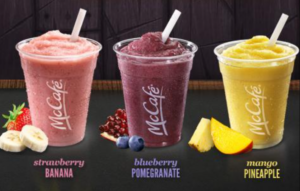
Strawberry Banana Fruit Blend:
Strawberry puree, banana puree, water, sugar, concentrated apple juice, and 1% other stuff. It’s 190 calories of mostly pure fructose.
They also add ice and low-fat yogurt for good measure. It’s a lot of “real” food—even the added sugar is real food. The ingredients make you feel better (emotionally) but the health consequences are almost equivalent to drinking pure sugar water. And then calling it health food. The sad thing is, these mostly “real food” smoothies aren’t wildly different than a lot of smoothies people are making at home.
Just Because it’s Natural Doesn’t Make it Healthy
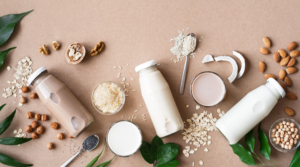
At Skinny Bitch we advocate for a whole food diet as the only way to maintain permanent weight loss, but sugar and fruit are natural. What do we do here?
Do the smoothies you make at home resemble McDonald’s? Even 50% McDonald’s? It’s appalling, but take a minute to be honest with yourself. Are you convincing yourself that your “green” smoothies are healthy because, besides the pineapple, mango, orange juice and banana, you also throw in 4 kale leaves? “Kale is a healthy, green veggie” you tell yourself as you suck your sugary smoothie through a large pink straw.
Do you want to be thin and thriving or do you want to lie to yourself about what you’re putting in your body? If you want to actually benefit from drinking smoothies, they need to be green in color–not a tropical peachy/orange color. Do the ingredients of your green smoothies resemble a salad? Or are they closer to a Jamba Juice?
Why is this?
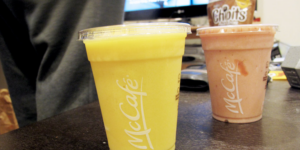
Because there is overwhelming evidence that consuming lots of vegetables equals less illness and disease in your life, that’s why. And, there is hardly a faster or easier way to consume large amounts of vegetables than by throwing them in a blender (our favorite LOVE of a blender) and drinking the results. Not to mention the increased absorption of vitamins and nutrients from plants that have been pureed in a blender.
A real “green” smoothie should not taste like fruit juice. Just like your dinner salad, a green smoothie can be slightly sweetened with the addition of an apple and a few berries, but that’s it.
What the Fructose?!
Let’s talk a little bit about fructose because it is a confusing topic for some people.
Fruit smoothies taste so good because fruit is loaded with fructose.
A little lesson on sugars:
There are two simple sugars – glucose and fructose. Glucose is vital to life. Our bodies produce it and it is found in every living cell on this planet. When we eat starches like potatoes we are eating glucose. Glucose is vital to the life of every living thing.
Fructose on the other hand is not vital to life. We do not produce it in our bodies and for millions of years our ancestors ate very little of it except when certain fruits were in season just outside their cave. It was a special treat like cake on your birthday, once a year.
Here is the main thing you need to remember from this lesson:
Glucose and fructose are metabolized VERY DIFFERENTLY in our bodies. While every single cell in our body can instantly use glucose for energy, our liver is the only organ that can metabolize fructose.
So what happens when people, like most people in the Western hemisphere, consume high amounts of fructose? Our liver becomes overloaded and soon has to start turning all of it into fat. And we all know the ending to that story: Little Red Riding Hood became obese, developed type 2 diabetes and heart disease, and was on her way to developing cancer of the something-or-another.
Glycemic Index – Pay Attention to it
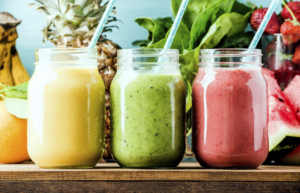
Many fruits have a high glycemic index which tells you it will easily and quickly spike your blood sugar levels after eating it. A banana, for instance, is loaded with fructose and will spike your sugar just as easily as a donut. Now, the banana happens to have a lot of beneficial fiber and other vitamins and minerals which makes it an obvious “better” choice over the donut. But for this topic, let’s be clear that it’s still gonna spike your blood sugar levels.
Not only do many fruits spike your blood sugar levels, but they then also spike your insulin levels. High insulin levels make you fat and give you diseases like heart disease and diabetes – end of story.
And What about Those Sugar Crashes?
As if developing chronic and deadly diseases wasn’t bad enough, do you really want to experience those crappy sugar crashes? Life is hard enough.
Why does this happen? Essentially, you eat a lot of sugar, too much in one sitting… your pancreas is then told to produce a whole lot of insulin to handle this sudden spike… the insulin then handles the spike and then your blood sugar levels dip to hypoglycemic levels, and you feel like crap.
As the saying goes “what goes up, must come down” (unless we’re talking about your weight, then that’s entirely up to you but the fruit smoothies isn’t helping). A sugar spike automatically leads to a sugar crash. So, yes, that banana mango smoothie tasted awesome, but now you start to crash and feel:
· Confused and out of it
· Anxious and weird
· Light-headed (and not in a good way like when you’ve had some Peppermint Schnapps)
· Really, really sleepy (and not in a good way like when you’ve had some Peppermint Schnapps)
· Headachey
· Irritable as f*ck
If you’re ready for some simple changes that can make dramatic differences in your waist line and your energy, keep reading on the next page.

